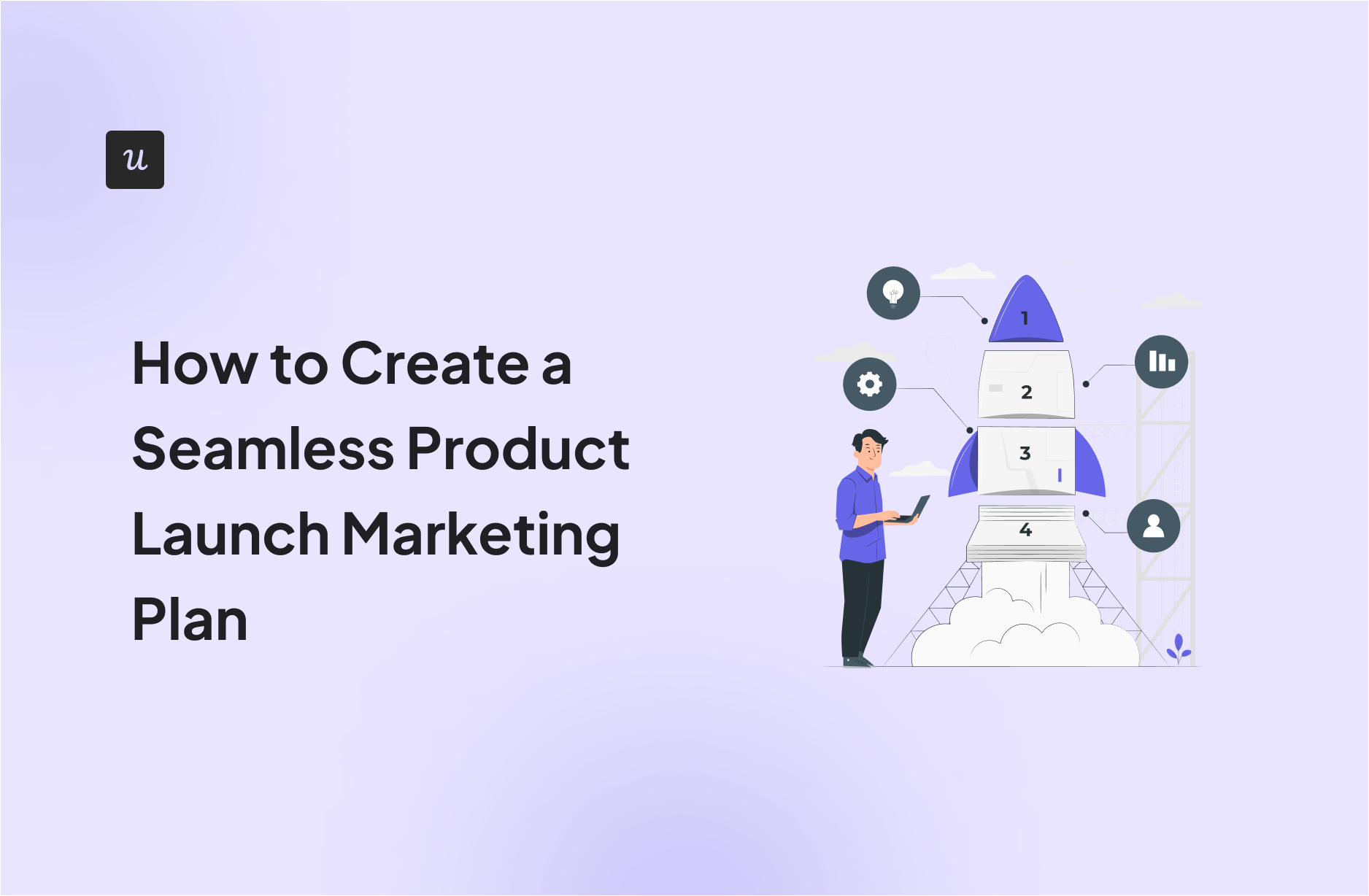
Try Userpilot Now
See Why 1,000+ Teams Choose Userpilot

What is a product launch marketing plan?
A product launch marketing plan is a coordinated effort to announce a new product and successfully bring it to market. It is a strategy designed to create awareness and get customers to adopt the product.
The product launch marketing plan is often a three-phase plan divided into:
- Pre-launch
- Launch
- Post-launch
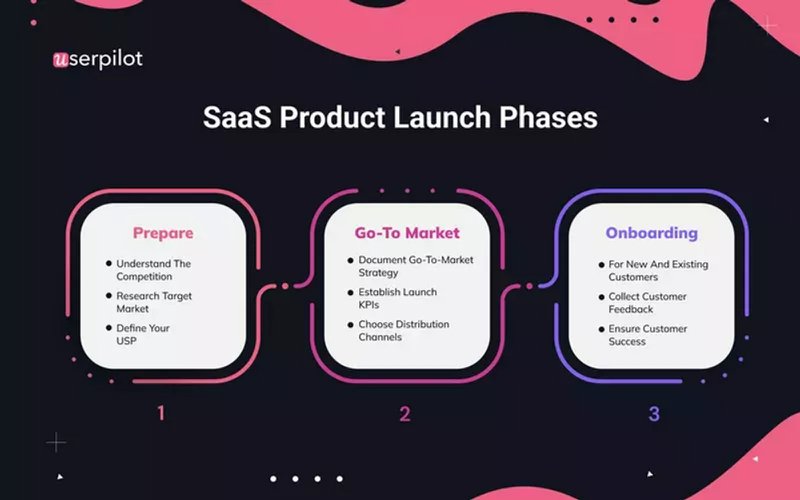
Launch phase
Pre-launch planning is key to your success on launch day. As your product launch date draws closer, compile the information from the pre-launch phase into a detailed go-to-market strategy.
Then, it’s time for execution. This is your time to create events, press releases, email marketing campaigns, ads, blog content, social media posts, etc., and release them on your pre-determined distribution channels.
This is also your time to leverage influencer marketing and referral programs to generate as much hype as possible.
Post-launch phase
With launch day now behind you, it’s time to retain your new, hard-won customers. Your post-launch plan should, therefore, consist of a detailed customer retention strategy.
This means onboarding your customers to ensure they get the most out of your product. You also need to collect customer feedback and implement any desired changes or upgrades.
Finally, this is the stage where you determine whether you enjoyed a successful product launch. Ask yourself:
- What KPIs are you tracking?
- How did you perform against your targets?
- What lessons can you learn for future product launches?
Why do you need a product launch marketing plan?
A product launch marketing plan provides structure and organization to your launch, helping you properly define your aims and launch timeline. A good launch plan, thus, empowers you for product launch success. How so?
For starters, it enables you to prioritize resources and prepare for most possibilities. A good launch plan also identifies your target audience, online and offline channels to find them, and how best to reach them.
All these increase your chances of reaching potential customers, generating valuable leads, and retaining them long-term. It also reduces any chance of product failure.
What should a product launch marketing plan include?
A product launch is a complex process, often involving multiple steps. To be successful, your product launch marketing plan needs the following:
Market research and target audience
The goal of product marketing is to make sales. For that to happen, the product marketing team must do three things:
- Understand the product and the problem that it solves.
- Determine what your competitors are doing.
- Identify the product’s end user and their unique needs.
All of these are what you’ll set out to achieve with your market research. First, you’ll need to understand what problems your product solves and how it works. Put simply, become a product expert.
Once you’re thoroughly familiar with your product, it’s time to examine the competition. Perform a thorough competitive analysis of their product – branding, marketing strategies, features/functionalities, pricing, etc.
Finally, you need to determine your target market. Who is your ideal customer? What’s their background – job, hobbies, age, etc.? What are their goals and pain points? In other words, create a detailed user persona.
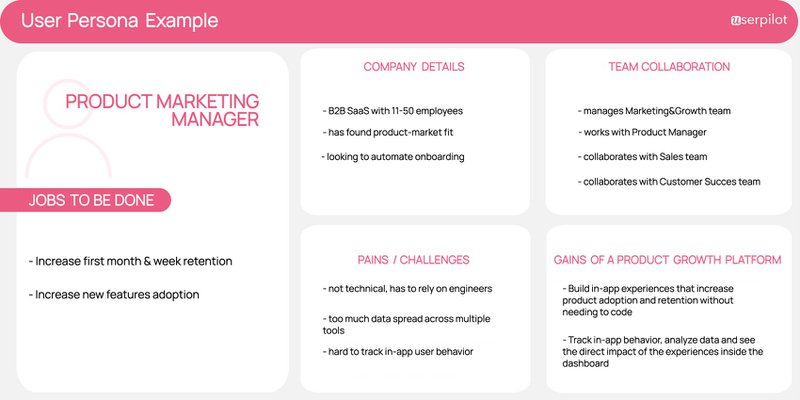
Product’s value proposition
A good value proposition is key to your product’s positioning or messaging. It refines the narrative around your product, focusing only on the most valuable aspects of the new product.
To create a powerful value proposition, you must answer the following questions:
- Who is your ideal customer? If you’ve already created your user persona, you have the answer to this question.
- What problems are they experiencing? Consider your customers’ pains, hopes, dreams, and needs that your product could address.
- How does your product solve that problem? Figure out how your product addresses the needs of your customer.
- How is your product different? Put differently, what’s your product’s unique selling point? Or, what advantages does your product have over the competition?
Go-to-market strategy
A go-to-market (GTM) strategy is a comprehensive roadmap for introducing your product to the target audience. Think of it as a marketing strategy that outlines all you need to do to enjoy a successful product launch.
It identifies your target customer, defines their need, and locates them. Then, it outlines the best marketing strategy (including how best to announce the product and when) to help you reach them.
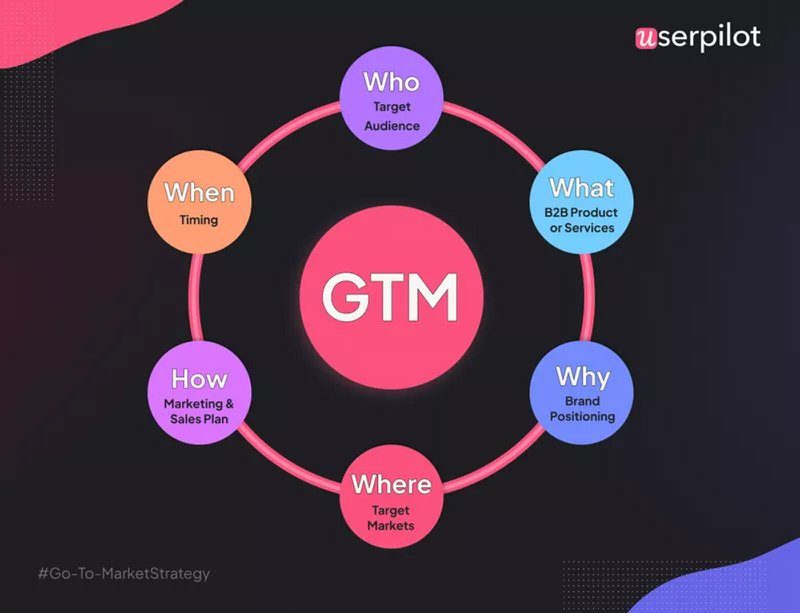
Your GTM strategy combines all you’ve learned from your market research and crafting your value proposition into a robust market entry roadmap that generates demand for your product and mitigates product launch risks.
Pricing and sales strategy
SaaS pricing models differ from traditional pricing models and should be more carefully considered. Although the subscription model is the preferred SaaS option, you’ll still have some questions to answer.
For instance, would you be better off with a flat-rate, usage-based, feature-based, or tiered monthly price? Likewise, you’ll also need a way to convince prospective customers to commit to ongoing payments.
For this, you’ll have three pricing strategies to consider:
- Free trial: Free trials allow users to test out your product before deciding whether it’s worth the price. This strategy reduces your customer acquisition cost as you optimize for trial-to-paid conversion.
- Freemium: The freemium model is ideal for complex products with multiple features. It exposes customers to a limited feature set, encouraging them to pay to access the full feature list.
- Demo: If your product has a steep learning curve, demos may serve you better. The show-and-tell format of this strategy enables you to qualify prospects before they subscribe.
Digital marketing strategy for various marketing channels
Your GTM product marketing strategy should inform the channels where you’ll find your audience (before and during launch day). Still, you have some decisions to make.
First, you’ll need to decide which channel will be the main one and which would support it. You also need to consider what you’ll share in each channel and when to share it.
For this, you’ll have five primary options:
- Social media marketing: Start creating shareable content and social media posts on platforms like Twitter, Instagram, etc. to enable you to reach a wide audience quickly.
- Press releases: Leverage (or create) relationships with newspapers, magazines, and other online publications to broadcast your launch. Develop clear content for professional media use and send them in advance of your launch date to your selected
- Email marketing: Announcing your product launch to a warm email list with an informative copy and a clear call-to-action.
- Media Outreach: If you do not have existing relationships with journalists, you’ll need to pitch them and explain why your press release deserves attention.
- In-app marketing: This option is ideal for big feature releases as it targets users who have already adopted the product.
Key performance indicators to measure launch success
The final component of your product launch plan is your measure of success. You and your sales team need to determine the key performance indicators (KPIs) to watch after the launch.
Not only do these metrics help you measure the success of your product launch, they also help you optimize the customer journey, improve your product, and fine-tune your content.
Some metrics to track include:
- Customer acquisition cost: The average amount your business spends to acquire one customer.
- Sign-ups to PQL conversion rate: Measures the percentage of new sign-ups that find your product useful and upgrade their account.
- Customer activation rate: The percentage of customers that complete your onboarding process and reach the ‘Aha’ moment.
- Trial to paid conversion rate: Tracks the percentage of customers that go from free trial to paying users.
- Customer engagement score: Measures how much each user engages with key product features and assigns them a score based on their actions/inactions.
- Customer retention rate: The percentage of customers you retain over a period. In SaaS, this often refers to customers who immediately renew their subscription plan.
- Customer Satisfaction Score: Tracks how happy customers are with your new product.
- Net Promoter Score: Assesses how likely a customer is to promote your product, making it a great measure of customer loyalty.
Best practices for a successful product launch marketing plan
Now that you know the different components of your product launch marketing plan, let’s now consider some best practices to ensure your plan yields success.
A/B test the messaging in your marketing materials
Good messaging communicates what your product does and the value it brings. It is simple, persuasive, and unique. Unfortunately, telling which message will best resonate with your target audience is challenging.
Thanks to A/B testing, though, it’s not impossible.
First, you’ll need to create multiple messages. Each message may adopt a different messaging strategy – emotional, positioning, pre-emptive, or unique selling proposition.
Then, you have to expose the messages to small samples of your target audience and see which one drives the most conversion.
Have a group of beta testers evaluate your product pre-launch
Much like your messaging, your product also needs to be tested before launch. Also known as pre-release testing, beta testing helps you get users to explore your product before launch day and provide feedback.
Beta testers get early access to the product in exchange for their feedback. As they use it, capture their stories, review how well they engaged with the product, and validate your value proposition (and messaging) with them.
This is your one chance to get real-world insights from your target customers regarding your product/feature. It’s also a great opportunity to identify and fix all bugs before launch.
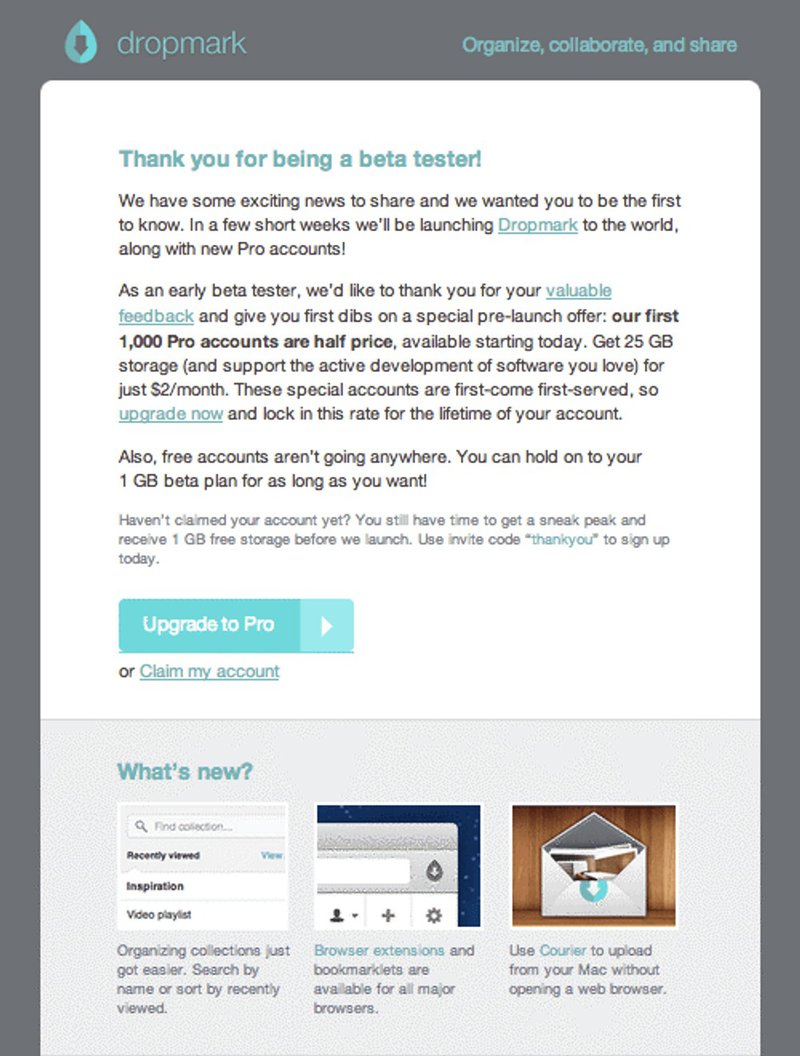
Collect customer feedback during the pre-launch stage
Getting user feedback is key to ensuring you’re ready for launch day. You can get feedback for your product through in-app surveys. This will help you iron out any issues users may experience before releasing to a larger audience.
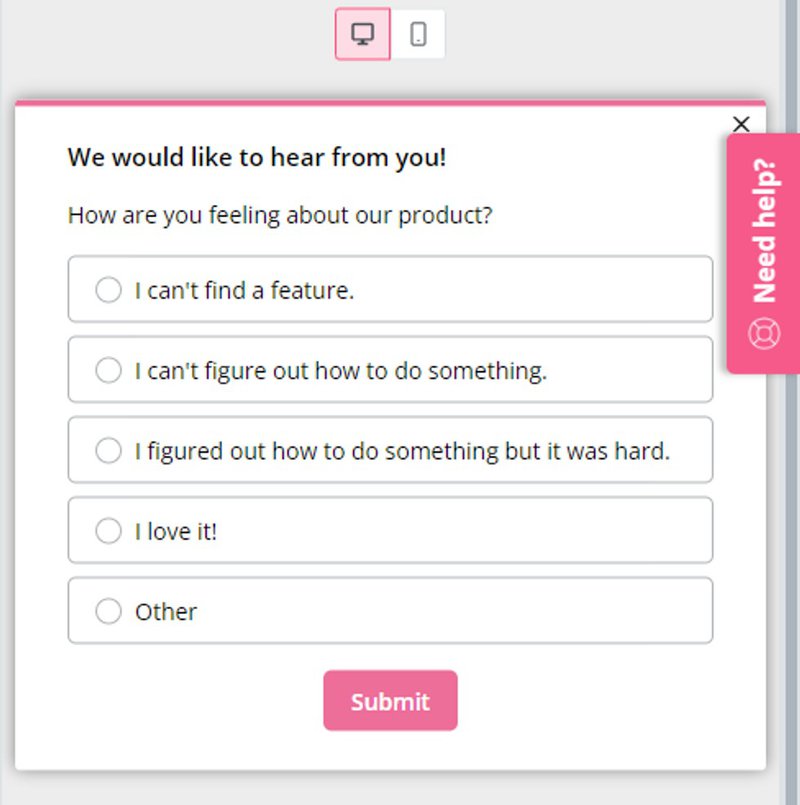
But it doesn’t stop there! You can create focus groups from your customer base and get their insights on your creative materials – texts, images, videos, landing pages, etc.
Note, though, that all of this feedback is only useful if acted upon. As you prepare your product and marketing materials for the big day, be ready to adapt them based on the feedback you receive.
Create excitement over your product before launching
You don’t need Apple-level hype to enjoy a successful product launch. But you don’t have to adopt the “build the product, and the customers will come” approach, either.
The key to a successful product launch campaign is generating excitement in all the right places—leverage search engines, Product Hunt, and social media posts to generate awareness about the launch.
For instance, you may release teaser videos or conduct interviews to get the word out. You can also turn your launch into an event (perhaps a Reddit AMA or a live webinar) to give the launch a more personal feel.
Create sharable content between your sales team and customer support team
Successful product launches are the result of complete internal cooperation and teamwork. As launch day draws closer, for example, you need your customer support team to be well aware of the product and how it works.
This calls for cooperation between the sales, support, and product teams. The product team needs to create easy-to-understand materials that demonstrate the product’s functions and features to the support team.
Similarly, the sales team needs to share content with the support team to enable them to drive home the necessary talking points when approached by prospective customers.
Analyze your in-app marketing strategies to improve customer retention
As earlier noted, a good product launch plan goes beyond the activities of the launch day. As you begin acquiring customers, your focus must shift to retention.
One way to ensure customer loyalty is by regularly improving the product. Analyze how customers interact with your product and ask yourself:
- Which features do they interact with the most?
- Are they interacting with key features?
- Are there any barriers keeping them from finding/using key features?
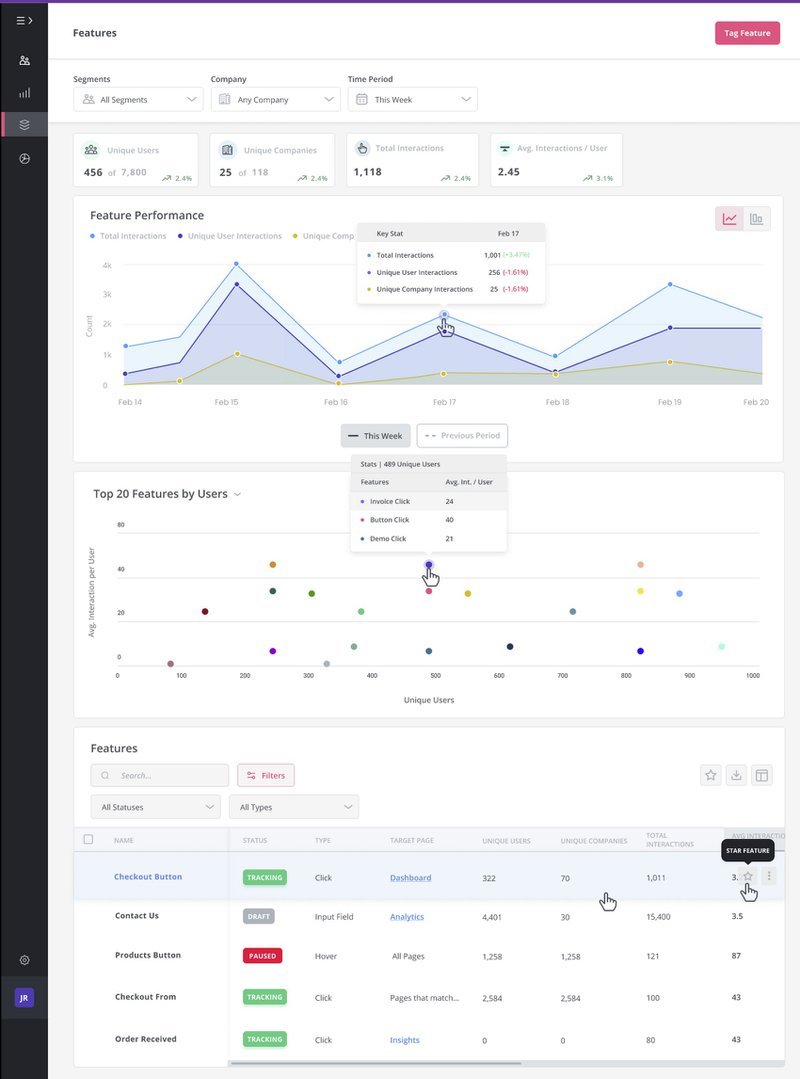
A solid long-term in-app marketing strategy will unlock your product’s value, eliminate friction, and improve the customer experience.
Examples of successful product launch marketing plans
Thankfully, there are tons of examples of successful SaaS product/feature launches. Consider a few of them:
Chat GPT
ChatGPT captured the world’s attention sometime in November 2022. But this was no accident. ChatGPT’s success wasn’t simply a result of its captivating features either (although that certainly helped!).
Instead, it resulted from a carefully orchestrated product launch marketing plan. First, the packaging of the model as a digital assistant made it easy for experts and noobs alike to use it.
Likewise, ChatGPT was very quickly promoted by influencers and thought leaders who encouraged users to ask the assistant any questions. People soon fell in love with its candor, versatility, and consistently factual answers.
The rest, as they say, was history.
Notion AI
Notion already existed long before it released its AI assistant to users, giving it an existing customer base to launch to. Still, they had to get the marketing just right.
First, Notion sent emails and used strategic in-app marketing to introduce users to Notion AI. Interested users were invited to a waitlist. They also used social media marketing to build anticipation within a larger audience.
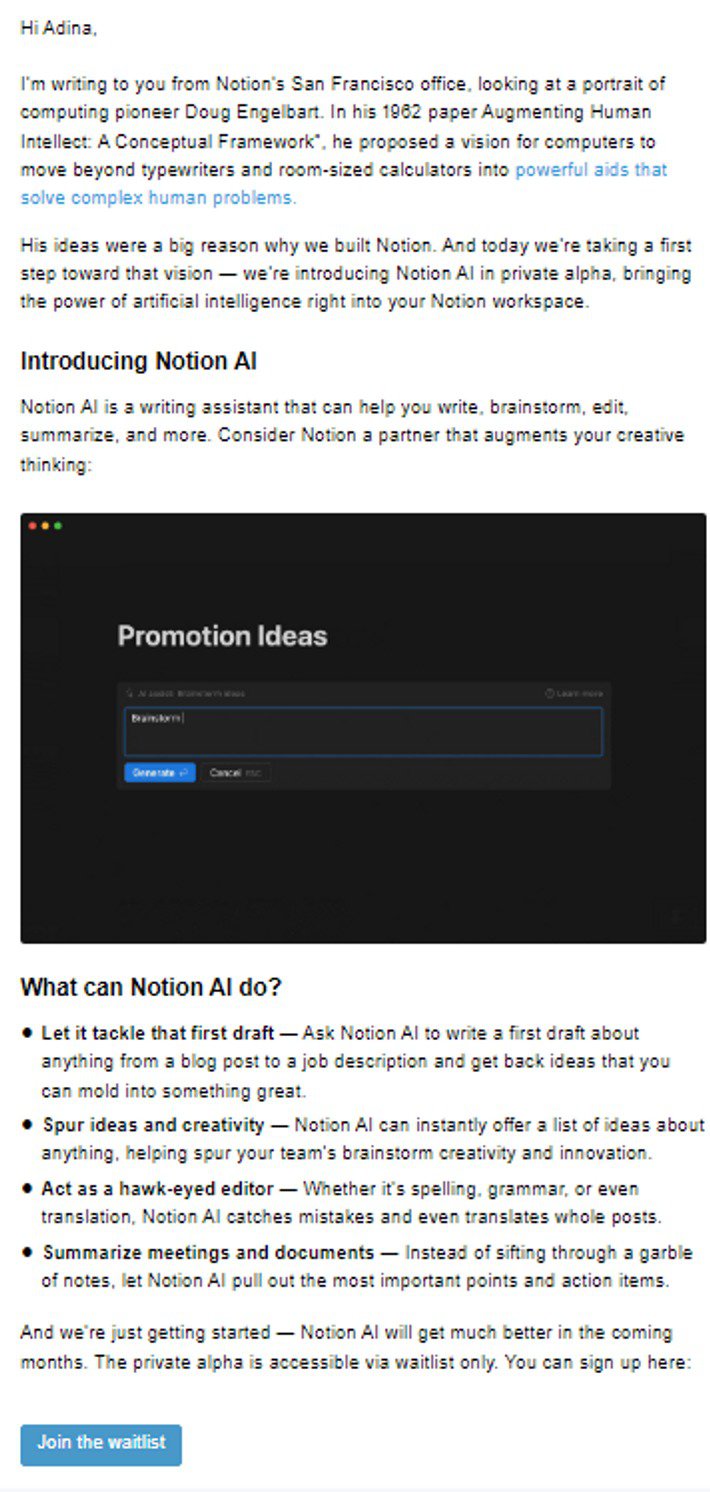
By the time Notion AI was released, about two million persons had signed up for its alpha waitlist.
Userpilot’s AI writing assistant
Userpilot released its own integrated generative AI writing assistant in May 2023. But, like the two examples above, Userpilot users were already in anticipation of it.
The feature was first introduced in-app and released to a limited number of users. These users tested the feature and left their feedback and insights.
As launch day drew closer, the feature was teased on social media before it was launched on Product Hunt. This created a buzz on Product Hunt, where users saw a demo video of the product’s capabilities.
Finally, by the time the feature was fully released, Userpilot used in-app onboarding and marketing to drive feature adoption.
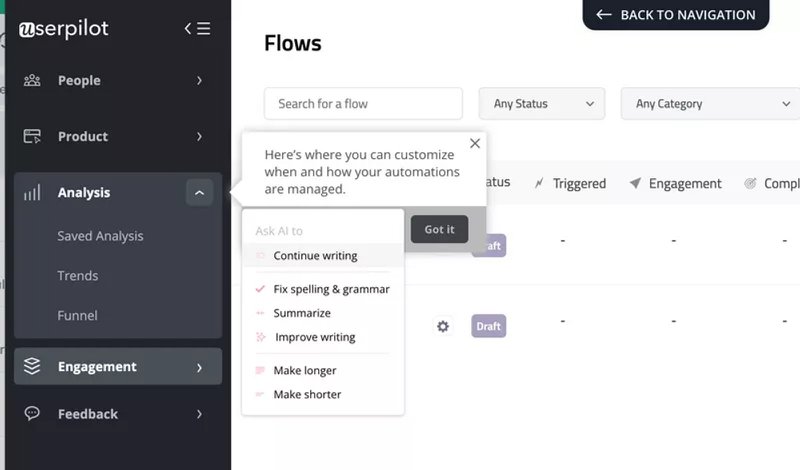
How Userpilot can help you with your product launch marketing plan
You, too, can replicate Userpilot’s successful in-app marketing strategy for your product launch. In fact, Userpilot provides you with a code-free selection of tools to help you:
Create in-app messaging with different UI elements
Userpilot provides a range of UI elements for announcing new features and running full-scale in-app onboarding or marketing campaigns.
This includes slideouts, modals, banners, tooltips, and more. The first three are ideal for in-app announcements and can contain anything from text content to embedded images, videos, GIFs, etc.
Conversely, tooltips are great for feature explanations. They can also be combined into a series for feature onboarding.
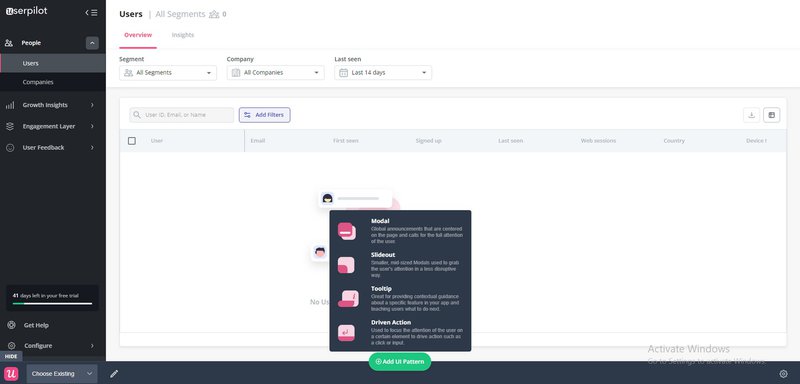
Segment customers acquired for a personalized experience
Create as many user segments as you desire and personalize their in-app experiences.
Userpilot enables you to build user segments based on a variety of factors – code-free. For instance, you could segment users based on their sign-up date, demographics, engagement data, and more.

You can also launch in-app surveys and match users to segments based on their responses to these surveys. Then, you will be able to create flows, messaging, etc. unique to the needs of each segment.
Analyze customer interactions to improve customer retention
Finally, Userpilot enables you to track how users use and interact with your product. In-app engagement analytics reveal which features, buttons, messaging, etc., that users engage with the most.
This will help you identify low-engagement or underperforming features, enabling you to locate and fix any friction points in your product.
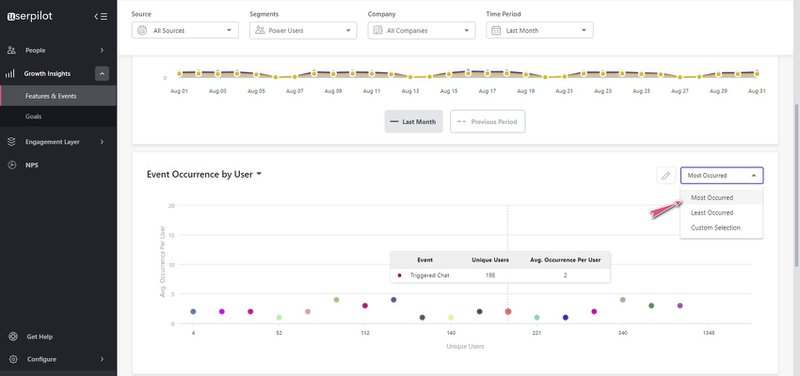
Conclusion
A solid product launch campaign gets you off to a great start. It enables you to reach the right customers early and increases the chances of product success.
If you’d love to learn more about how Userpilot can supercharge your in-app marketing campaign, book a demo today!






